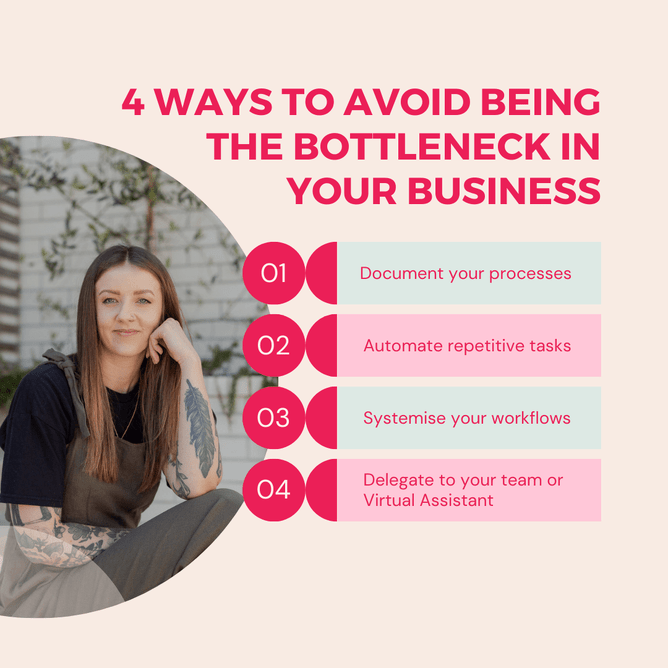As a busy business owner, you're no stranger to the overwhelming feeling of being inundated with tasks and responsibilities, often leading to bottlenecks that hinder your business's progress.
It doesn't have to be this way. There are simple strategies you can implement to streamline your operations and ensure your business runs smoothly. Let's dive into these tips and tricks tailored specifically for business owners like yourself.
Documenting Processes
One of the first steps towards avoiding bottlenecks is to document your processes comprehensively. Documenting processes involves creating clear, step-by-step guides for various tasks and workflows within your business. This ensures that when you delegate these processes to other team members, they're able to complete them accurately and efficiently.
Start by identifying the key processes within your business, such as sales, marketing, customer service, and product development. Then, break down each process into smaller steps and document them either in written form or via screen recordings. Include details such as who is responsible for each step, what tools or resources are needed, and any relevant deadlines or benchmarks.
Tip: tools like Berrycast, Loom and Tango.us make this process even easier, allowing you to screen record your processes as you complete them.
Regularly review and update your process documentation to reflect any changes or improvements. This ensures that your team always has access to the most up-to-date information and can perform their tasks efficiently, reducing the likelihood of bottlenecks occurring due to misunderstandings or miscommunication.
Automating Repetitive Tasks
Automation is a powerful tool for increasing efficiency and reducing the risk of bottlenecks in your business. By automating repetitive tasks, you can free up valuable time and resources that can be allocated to more strategic activities.
Identify tasks within your business that are repetitive, time-consuming, and prone to human error. These could include tasks such as email marketing, invoicing, and social media posting. Then, explore automation tools and software solutions that can help streamline these processes.
For example, you can use CRM software to automate lead nurturing and follow-up processes, or accounting software to automate invoicing and payment reminders. Likewise, with social media management tools you can schedule posts in advance, freeing up time for your team to focus on more creative aspects of social media marketing.
Systemising Workflows
Systemising workflows involves creating standardised procedures and protocols for completing tasks within your business. This ensures consistency and efficiency across all departments, minimising the risk of bottlenecks.
Start by mapping out your workflows for key processes, such as what happens when a new client comes on board.
Project management tools such as Teamwork, Trello, Asana, or Monday.com can help systemise workflows by allowing you to assign task lists with the click of a button, set deadlines, track progress, and communicate with team members in real-time, ensuring that everyone stays on the same page.
Delegating to Team Members and Virtual Assistants
Delegating tasks is essential for avoiding bottlenecks and scaling your business effectively. As a business owner, it's important to recognise that you can't do everything yourself and that delegating tasks to your team members or virtual assistants can help lighten your workload and empower others to take ownership of their responsibilities.
Start by identifying tasks and projects that can be delegated to others based on their skills, experience, and availability. Use your newly documented processes and systemised workflows to clearly communicate expectations, deadlines, and desired outcomes.
When delegating tasks, it's important to trust your team members and give them the autonomy to complete their work without micromanaging. Provide support and guidance when needed, but avoid being overly controlling or intrusive, as this can hinder productivity.
If you don't have a dedicated team in-house, a virtual assistant is the perfect solution. Virtual assistants can help with a wide range of tasks, including administrative support, customer service, social media management, and content creation, allowing you to focus on more strategic aspects of your business. In many cases, a VA will even be able to take on the responsibility of documenting, systemising and automating your tasks for you, removing the potential of another bottleneck.
As a busy business owner, you understand the challenges of managing tasks and responsibilities without becoming the bottleneck that slows down your business's progress. However, by implementing the four key strategies outlined in this article—documenting processes, automating repetitive tasks, systemising workflows, and delegating effectively—you can streamline operations and ensure your business runs smoothly.
When you're ready to get started, book a call with us to chat about how a virtual assistant can keep things running smoothly in your business.



